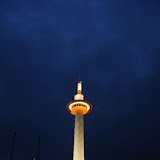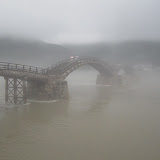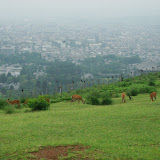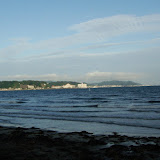In the category of undisputed former capitals of Japan,
Nara has a pretty safe spot. For 74 years, from 710 to 784, Nara was the seat of power until it moved to Kyoto, first to the outskirts for a decade, and then in 794 to its long-term home. During Nara's brief supremacy--a time aptly known as the Nara period--Buddhism began to captivate the upper classes, and Nara's numerous Buddhist temples reflect this growing interest. Many of the city's most historic sites were ransacked during a bout of anti-Buddhist sentiment during the Tokugawa shogunate in the 19th century, but a diligent preservation effort has restored or reconstructed many works of art (mainly statuary) that could have been lost for all time.
The easiest way to get to Nara from Kamakura ended up being via Tokyo, so I rode the train back, only a day after having said goodbye, and caught an overnight bus, called the 'Youth Dream Nara'. The youth means budget, and the bus was decidedly lacking in the amenities department. Two of the most touted features of the Dream Nara in comparison to its counterpart are bigger seats, and a blanket. Not fully appreciating the latter of these two services, I boarded in my shorts and t-shirt, having stowed my luggage under the bus, and subsequently realized my mistake. The bus was cold! And the seats were tiny! I probably should have seen it coming. Luckily, I didn't have a seat partner, so I was able to stretch out horizontally and catch some winks. The ride was a little surreal, since the shades were drawn over all of the windows, I lost all sense of space, and dozing in short bursts, I quickly lost track of time. Nine hours later I stepped out of the bus in a mental haze, not fully comprehending how far or in what direction I had come.
Soon enough, though, I shook off my fog, checked into my guesthouse, and went exploring. One of the most interesting things about Nara, and the aspect of the city that preoccupied most of my first day is the fact that deer roam freely about the town. The main shrine in the city worships a
kami who supposedly rode from the forest on a white deer. As a result, deer have been sacred in Nara for more than a thousand years. As it turns out, a thousand years is plenty of time to embolden woodland creatures. The cheeky deer spend their days harassing tourists for
shikai (deer)
senbei (rice-based crackers), which are sold throughout the common areas. The bucks' antlers are dulled every year to prevent accidents, but the deer still know how to use them for leverage. The male deer were on the whole a little bolder, and didn't hesitate to gang up to intimidate. I saw more than a few tourists try to give one
senbei to one deer, and end up nervously tossing a whole stack to escape as other eager deer surrounded them, sometimes nudging with antlers, and sometimes trying to eat clothing. In the most highly trafficked areas, deer don't even need the hint of
senbei to investigate, and I played a game of petting the deer without feeding them for as long as they would tolerate me--rarely longer than a minute, it turned out.
Below: Deer, like most animals, love to be scratched behind the ear, apparently.
That night, I spent several hours talking to the wonderful couple that operated the guesthouse. A quick word on guesthouses--they mostly, but not always, feature hostel-equivalent accommodation, but are usually run by a family, and in the house in which they live. They offer a nice alternative to the sometimes sterile environment of the hostel, and Guesthouse Naramachi, run by the Anzai family, embodied this distinction. Both of the Anzais spoke English well and were eager to practice it, and we talked well past the lights-out curfew that they mandate. Mrs. Anzai is a retired schoolteacher, and Mr. Anzai was a salaryman with Sharp, before retiring. Last year they bought and began operating the guesthouse, and they seem like they couldn't be happier. After they found out my next stop was Koyasan, Mr. Anzai brought out the family's
mandala and told me about Japanese Buddhism, and about the particular sects, Shingon and Pure Land, that are prevalent in and around Koyasan. After realizing how late the night had gotten, we all retired, and I set my alarm for early the next morning to get a jump on all of the sights.
The temples around Nara are incredible, mostly thanks to the ancient artwork within. As a a general rule, few buildings in Japan are more than 400-500 years old. Since buildings were traditionally constructed of wood in order to survive earthquakes, fire was a constant threat in ancient Japan, and most buildings have suffered fire at some point or another. As a result, many temples with incredibly old histories are comprised of buildings from the last few centuries. In contrast, much of the statuary within the buildings, and particularly within a museum erected over an old temple site, dates back to the actual Nara period. Seeing incredibly intricate wooden statues that date back over a millennium was amazing to me. The museum at Kohfukuji housed the most interesting statuary, but didn't allow photography. There are pictures on the website, but its menus are in Japanese. I've not been able to find my favorite statue, but here's one of 12 different mythical generals, and I believe they're from the twelfth century.

After temple-hopping throughout the day, and seeing most of the main sites, I wandered north from Todaiji, the biggest temple complex (Home to what I mistakenly called the largest Buddha statue in Japan in an earlier post. According to
this list, its actually sixth. My bad.) Behind the northernmost building of the complex I spotted a small path, and a
temizuya (lit. hand water place), the water basins at which one purifies before entering any Shinto shrine. Intrigued, I washed my hands, first left, then right, rinsed my mouth, carefully poured the last of the water over the handle of the dipper, and then embarked on the trail. I expected the trail to lead a few hundred yards to a small, personal shrine. I passed a few grave markers, but the trail continued to climb. As I ascended, the trail became progressively harder to follow, and the bugs intensified. As the blisters in my sandals began to become raw, I repeatedly considered turning back, but always one to be motivated by
sunk costs, I persevered.
I began periodically to pass covered, red, steel barrels dug into the ground and filled with water, and I realized that I was on a poorly maintained firewatch path. By about the third barrel, I could see sky ahead, and the trail began to open up. Soon, I was looking up at a grassy ridgeline. I continued along the path as it switchbacked up the hill. Two more fire barrels, and a lot more climbing, and I had arrived:
High Above Nara from
Mitchell Brooks on
Vimeo.
On the side of the mountain grazed two or three dozen deer much less accustomed to human activity. One screamed as I approached, and any sudden movements during my half-hour on the ridge were sure to incite flurries of movement as deer sprinted to maintain a safe distance.
Afterward, I descended from the other side of the ridge--along a much more well-kept path, and found myself in the Kasuga Taisha primeval forest, dedicated to the aforementioned deer-riding god. The forest is a sort of counterpoint to the spacious complexes of the Buddhist temples, and serves as a sprawling Shinto complex, complete with dozens of small shrines networked by trails and trails. It was nearly seven, and the light was fading fast. I lingered, discovering quickly that a primeval forest littered with shrines and stone lanterns is a pleasantly creepy place to wander around dusk.
I emerged just at full dark, and began making my way back to the guesthouse. It had sprinkled off-and-on throughout the day, but only as I began walking did it begin to rain in earnest, and, already tired, I was quickly ready to be dry and in bed. So of course, I got lost. I realized when I saw a road sign indicating the direction to Nara that I had gone astray somewhere. Frustrated, wet, and hungry, and with slim pickings for eateries I stopped in a somewhat seedy-looking ramen shop to regroup and refuel. Inside, I was met by an incredibly friendly older couple who gave me a heaping portion of ramen, and then treated me to an unexpectedly tasty concoction of peanut butter and cider. By cross-referencing my maps, I soon realized that I was not far off-course. After my meal, warmed by the noodles and hospitality I was ready to set out, but before I could, the old lady proudly gave me a gift, a small jingling bell surrounded by folds of fabric. They sell similar charms at temples, and I think they're good luck charms. She pinned it to the pocket of my zipper, and I bowed low as I left.
Photos:



























